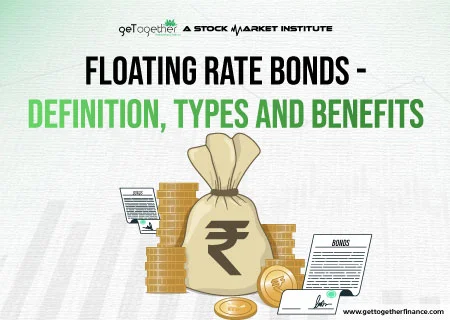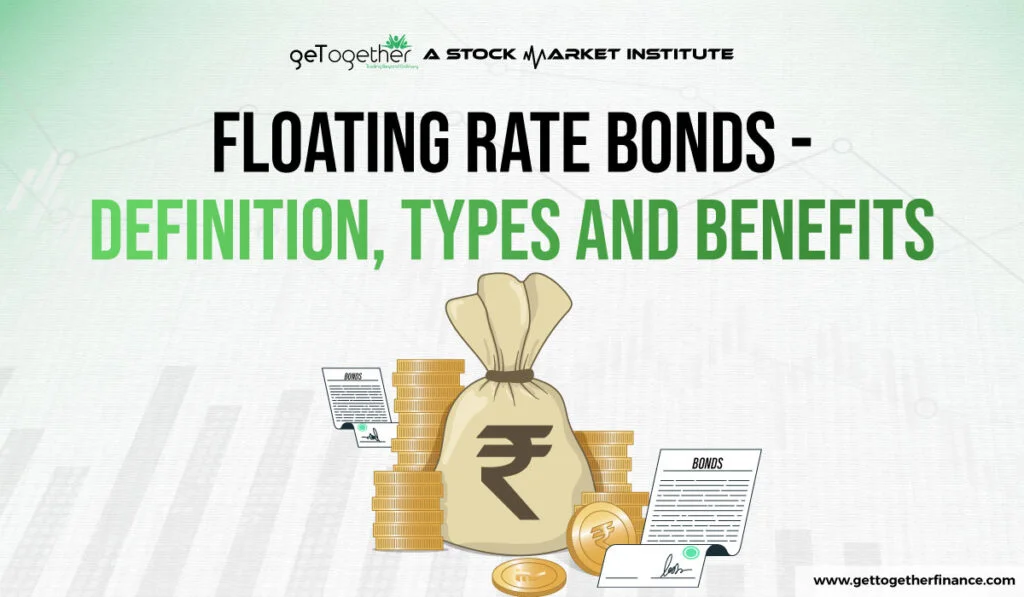Floating Rate Bonds – Definition, Types and Benefits


The world of fixed-income investments can be a haven of stability, offering predictable returns and a steady stream of income. However, when interest rates start to fluctuate, that predictability can vanish, leaving investors exposed to potential losses. Floating rate bonds (FRBs) are a unique type of debt instrument, offering compelling investment options to investors for navigating a dynamic interest rate environment.
With this blog, we will explore the definition of floating rate bonds, along with its advantages and disadvantages. Further, it will dive deeper into the different types of FRBs with examples to understand the concept thoroughly.
Table of Contents
ToggleWhat is a Floating Rate Bonds?

Contrary to traditional fixed-rate bonds that offer a predetermined interest rate (coupon) throughout their lifespan, FRBs have variable interest rates. These rates are reset periodically, typically every quarter or year, based on a benchmark index, such as LIBOR (London Interbank Offered Rate) or the prime rate.
Unlike the US market with a diverse range of FRB issuers, India’s FRB domain is dominated by the government. The primary issuer of FRBs in India is the Reserve Bank of India (RBI), which issues them under the name of Floating Rate Savings Bonds (FRSBs). These bonds function similarly to traditional FRBs but cater to retail investors.
How Do Floating Rate Bonds Work?

Floating rate bonds (FRBs) offer a unique twist on traditional fixed-income investments. Unlike their fixed-rate counterparts, FRBs don’t lock you into a single interest rate for the entire bond term. Instead, they boast an interest rate that adjusts periodically, typically every quarter or year.
Here’s what you need to know about how FRBs work:
1. Initial Investment
You purchase an FRB at its issuance price, similar to a fixed-rate bond.
2. Interest Rate Benchmark
Unlike fixed-rate bonds with a locked-in rate, FRBs are linked to a benchmark index. This index, often LIBOR (London Interbank Offered Rate) or a national treasury bill rate, reflects prevailing short-term interest rates in the market.
3. Interest Rate Reset
The key feature of FRBs is their periodic interest rate adjustments. This reset frequency can vary by bond, but it typically occurs quarterly, semi-annually, or annually. The interest rate on your FRB isn’t static; it’s reset based on the chosen benchmark index.
4. Interest Payment
Throughout the bond’s term, you receive interest payments calculated using the adjusted interest rate. This ensures your income stream reflects changes in market conditions, particularly fluctuations in interest rates.
Types Of Floating Rate Bonds

Here is a breakdown of different types of floating rate bonds (FRBs) that investors can opt for:
Floating-to-Fixed Rate Bonds
Initially, the interest rate on these bonds is variable, but it becomes fixed on a predetermined date. These bonds are ideal for investors anticipating a decline in interest rates, as they guarantee a higher fixed interest rate for the fixed period.
Inverse Floating Rate Bonds
The interest rate on these bonds moves inversely to a benchmark rate. When the benchmark rate rises, the bond’s rate falls, and vice versa. Investors expecting a drop in interest rates may find these bonds appealing, as they can yield higher returns in such scenarios.
Step-up Callable Bonds
These bonds have a set rate schedule that increases over time. The issuers can buy back these bonds on certain dates, often coinciding with the step-up dates. Rising interest rates benefit investors, but these bonds come with call risk if the issuer decides to redeem them early.
Perpetual Floating Rate Bonds
These bonds have no maturity date and continue to pay interest indefinitely. The interest rate usually adjusts based on a benchmark rate. They might appeal to investors seeking a steady income stream, but they carry higher credit risk and price volatility compared to bonds with a set maturity date.
Fixed Rate Bond Vs Floating Rate Bond

The main difference between a fixed-rate bond and a floating-rate bond is pretty straightforward. With a fixed-rate bond, the interest rate stays the same for the entire duration. On the other hand, a floating-rate bond has an interest rate that’s tied to a benchmark, like a bank or treasury rate, and it changes regularly based on what’s happening in the market.
Here is listed the difference between fixed rate bonds vs floating rate bonds in simpler terms:
| Feature | Fixed-Rate Bond | Floating-Rate Bond |
| Interest Rate | Fixed throughout term | Periodically adjusts |
| Interest Rate Risk | Lower | Higher |
| Market Performance | Generally performs well in falling interest rates | Can outperform in rising interest rates |
| Income Predictability | Predictable income stream | Income stream can fluctuate |
| Advantages | Predictable income stream Lower interest rate risk | Hedge against rising rates Potential for higher returns |
| Disadvantages | Limited potential for higher returns Early redemption penalty | Income stream volatility Higher interest rate risk |
Floating Rate Bonds Advantages & Disadvantages

Floating rate bonds (FRBs) offer an interesting twist on traditional fixed-income investments. They provide a way to earn interest while managing some of the risks associated with fluctuating interest rates. Here’s a breakdown of the key pros and cons to consider:
Advantages of FRBs
- Hedge Against Rising Rates: FRBs boast a key advantage: protection against inflation. As interest rates rise, the coupon payment on your FRB adjusts accordingly, ensuring your income stream keeps pace with inflation. This makes them a good option for investors concerned about rising inflation eroding the purchasing power of their fixed-income investments.
- Potential for Higher Returns: In a rising interest rate environment, FRBs can outperform fixed-rate bonds. Since their coupons adjust periodically, FRBs can capture these increases, potentially offering higher returns than bonds locked into a fixed rate for their entire term.
- Reduced Interest Rate Risk: Compared to fixed-rate bonds, FRBs offer some protection against rising interest rates. While interest rate fluctuations can impact both types of bonds, FRBs can adjust their rates to compensate, mitigating some of the risk.
Disadvantages of FRBs
- Income Stream Volatility: Unlike fixed-rate bonds that offer a predictable income stream, FRBs can be more volatile. The interest rate resets based on a benchmark index, so your income can fluctuate with changes in the market. This can make budgeting and financial planning more challenging.
- Higher Interest Rate Risk (Falling Rates): While FRBs protect against rising rates, they don’t eliminate interest rate risk entirely. If interest rates fall, the coupon on your FRB will also decrease, potentially leading to lower returns than a fixed-rate bond issued at a higher initial rate.
- Lower Potential Returns (Stable Rates): In a stable interest rate environment, FRBs may not outperform fixed-rate bonds. Since their coupons adjust periodically, FRBs may not capture significant gains if rates remain steady. In such scenarios, a fixed-rate bond with a high initial coupon rate might offer a better return.
- Limited Liquidity (Some FRBs): While some FRBs trade on secondary markets, others, like India’s Floating Rate Savings Bonds (FRSBs), are not tradable. This limits your ability to sell your FRB before maturity if you need access to your capital.
Also Read: Government Sovereign Bonds
Conclusion
FRBs can be a valuable tool for investors seeking to manage interest rate risk and potentially benefit from rising rates. However, it’s crucial to understand the inherent income stream volatility and potential downsides before investing. It is super important to carefully weigh the merits and limitations and consider your risk tolerance and investment goals to determine if FRBs are the right fit for your portfolio.
FAQs
Who should consider investing in floating rate bonds?
Investors who are seeking protection against rising interest rates can find it a suitable instrument. Besides, investors who are comfortable with some income variability unlike the predictable stream of fixed-rate bonds can also consider investing in floating rate bonds.
What is the duration of a floating bond?
FRBs have a set maturity date, just like fixed-rate bonds. The duration refers to the remaining time until the next interest rate reset, not the entire bond term.
Are floating rate bonds taxable?
Yes, the interest earned on FRBs is generally taxable as income according to your tax bracket.
Are Floating Rate Bonds A Good Investment?
Floating rate bonds can be attractive during periods of rising interest rates. This is because their interest rates adjust automatically, offering a layer of protection against volatility in the market.



 Facebook
Facebook Instagram
Instagram Youtube
Youtube
